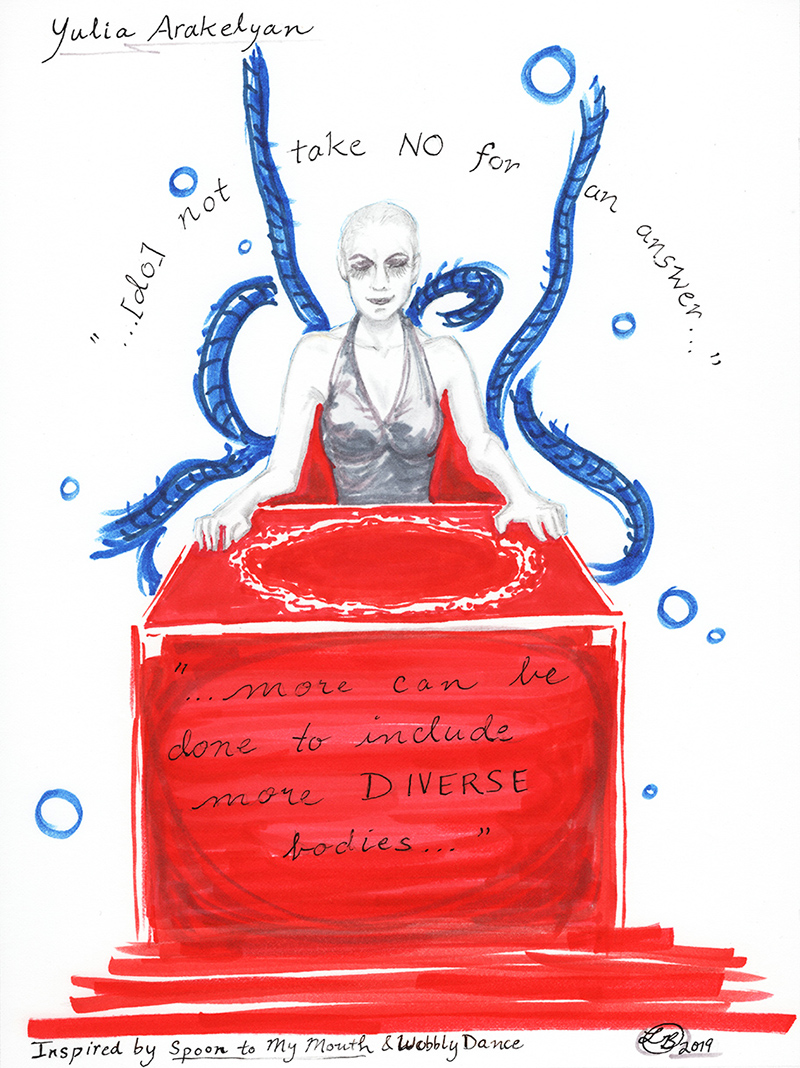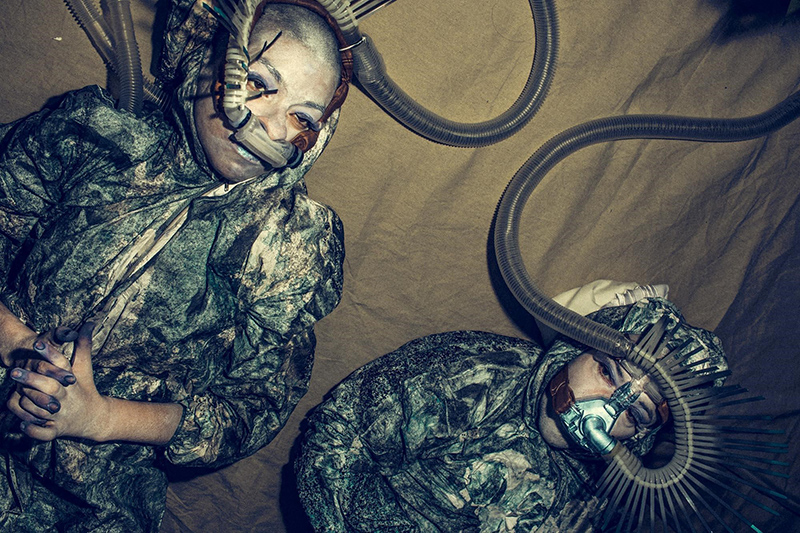Yulia Arakelyan: “It’s Not ‘Despite,’ It’s Because Of Our Unique Bodies”
BY EMMALY WIEDERHOLT; ILLUSTRATION BY LIZ BRENT-MALDONADO
Yulia Arakelyan is a Portland based performance artist who earned a BA in Dance from the University of Washington and additionally studied with Candoco, Diego Piñón, Jurg Koch, Sheri Brown, Mizu Desierto, Miguel Gutierrez, and Yukio Suzuki. Along with partner Erik Ferguson, Yulia founded Wobbly Dance in 2006, a multidisciplinary performance project currently focused on creating dance films. As an educator, Yulia was a regular guest teacher at the annual Integrated Dance Summer Intensive at the University of Washington, and has also taught at Patrick Lynch Elementary School, Polaris Dance Institute, Echo Theater Company, Butoh College, and Beaumont College.
To learn more about the Discussing Disability in Dance Book Project, visit here!

Image description: Yulia is depicted seated behind a large red cube, her hands resting on top. She stares intently ahead. Blue tube-like strands float behind her. She is wearing a gray halter top. The words “[do] not take no for an answer…” curve above her head and “…more can be done to include diverse bodies…” appear etched into the front of the cube.
~~
How did you get into dance and what have been some highlights in your dance history?
After high school, I went to a community college in Seattle for two years and took theater classes every term. Through theater, I realized I really like moving onstage and decided that I wanted to dance. I started to search online for integrated dance companies. I didn’t quite know what search terms to use, and I must have tried everything. To my surprise, there was so much info out there: disabled dancers and companies are all over the world! Through that research, I learned about Light Motion Dance in Seattle. I went to one of their performances and afterwards went up to Charlene and asked if she would teach me to dance. That was in 2003. I have been dancing, moving, and performing since.
Through dance, I found community and discovered disability culture. I have met amazing friends and artists. It was also through dance that I met my partner of 12 years, Erik Ferguson. Dance has allowed me to travel nationally and internationally. With Wobbly – the multidisciplinary performance project Erik and I founded – I am so grateful to have such an incredibly strong and creative team of collaborators: Jenny Ampersand (costume/set designer), Ian Lucero (cinematographer), Nathan H.G. (actor, dancer, stage and rehearsal manager, lighting designer) and Sweetmeat (musicians). We have been collaborating for more than four years and together we have created two short dance films, several performances, and a promo video. It’s amazing to me that these people believe in Wobbly’s vision and want to help our vision become a reality!
How would you describe your current dance practice?
Recently, I have been focused on training to become a software engineer and it has taken up all my time and energy. I’m not changing careers, but I am adding a career that is interesting to me and that can financially support my art career. Wobbly recently finished our second dance film, Tidal. We were also hired to choreograph an original rock opera with the PHAME Academy last summer, which was exciting and scary at the same time. My body has changed a lot (and keeps changing) over the past several years. I am no longer the same dancer I was 10 years ago, or even two years ago. Sometimes it’s a struggle to keep calling myself a dancer when I can no longer move most of my body but, at the same time, these new limitations force me to find new ways of creating art. Wobbly’s new film, Tidal, was mostly shot with me lying on my back and using my different types of ventilators so I could still breathe.
When you tell people you are a dancer, what are the most common reactions you receive?
I’ve gotten some pretty funny reactions over the years:
“How do you dance?”
“Do you, like, wave your arms around?”
“This is a dance class; why are you here?”
I’m sure there are more, but I can’t remember right now.
What are some ways people discuss dance with regards to disability that you feel carry problematic implications or assumptions?
My biggest frustration is when people (and you see this a lot in articles and inspirational porn videos) say things like:
“Despite not having arms and legs….”, “Despite being paralyzed from the waist down….”, “Despite being in a wheelchair…”
NOOOOOO! It’s not “despite.” It’s because of our unique bodies that we are the amazing dancers (and people) that we are.
For press, I would say write about the artistry and creativity of a particular dance piece. Don’t focus on, “Oh, it’s so inspiring to see disabled people onstage.” Go beyond that. Be critical. What worked for you in the piece? What didn’t? Write about what you saw. Describe the dancing bodies. But please, please don’t ever focus on a dancer’s medical diagnosis. And don’t ever say “wheelchair bound.”
Do you believe there are adequate training opportunities for dancers with disabilities? If not, what areas would you specifically like to see improved?
No, but people in our field are working to change that. For the most part, if you are disabled and you want to become a professional dancer, you are going to have to create your own training opportunities and not take no for an answer.
Would you like to see disability in dance assimilated into the mainstream?
Yes and no. I think there is value in having our own festivals and communities, but I also think those are too limiting.
What is your preferred term for the field?
DANCE!
In your perspective, is the field improving with time?
For sure! There is more visibility now with people like Alice Sheppard and others paving the way. But I do think more can be done to include more diverse bodies in this field, like more professional dancers who use powerchairs, ventilators, or people with developmental disabilities. The physically integrated dance world can be very exclusive as to the type of disabled bodies that are hired and seen.

Photo by Kamala Kingsley
Image description: Yulia and her dance partner are pictured from up above as they lie on their backs on top of a gray sheet. They are both using ventilators that are adorned with spikes. Yulia’s hands are clasped on her stomach. They are both wearing metallic gray full-body suits with white makeup on their faces.
~~
To learn more about Wobbly Dance, visit www.wobblydance.com.
To learn more about the Discussing Disability in Dance Book Project, visit here!
